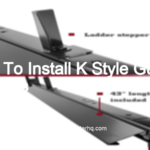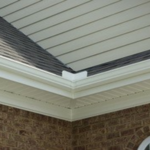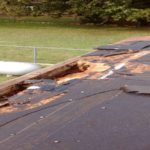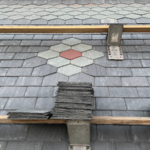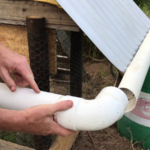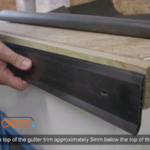There are several types of gutter hangers, each with their own benefits and drawbacks. The most common type of gutter hanger is the J-hook hanger, which is easy to install and provides a strong hold. However, J-hook hangers can be difficult to remove, and they are not compatible with all types of gutters. another common type of gutter hanger is the screw-in hanger, which is also easy to install but can loosen over time. For a more permanent solution, you can install a spike and ferrule hanger, which penetrates the gutter and is held in place with a metal ferrule. Spike and ferrule hangers are more difficult to install, but they provide a very strong hold.
What are the different types of gutter hangers?
- J-Hooks: J-hooks are the most commonly used type of gutter hanger. They are easy to install, and they provide a secure hold for your gutters. J-hooks also allow for easy adjustment and removal of gutters, if necessary.
- L-Brackets: L-brackets are another type of gutter hanger that is commonly used. They provide a secure hold for your gutters, and they are also easy to install. L-brackets, however, are not as easy to adjust or remove as J-hooks.
- S-Hooks: S-hooks are yet another type of gutter hanger. They are similar to J-hooks in that they are easy to install and provide a secure hold for your gutters. S-hooks, however, are not as easy to adjust or remove.
- Straps: Straps are a type of gutter hanger that is used in conjunction with another type of hanger, such as J-hooks or L-brackets. Straps provide additional support for your gutters, and they are easy to install.
What are the different types of gutter clamps?
- Slip Clamps: These clamps have a U-shaped bar that fits over the gutter and a set screw that tightens down on the bar, holding it in place.
- Hinged Clamps: These clamps have a hinge in the middle that allows them to be opened and closed. They are typically used on gutters that are not perfectly level, as they can be adjusted to fit snugly against the gutter.
- Screw Clamps: These clamps have a screw that goes through the gutter and into the fascia board. They are very easy to install, but they can be harder to remove if you need to make repairs to the gutter.
- Nail Clamps: These clamps have a small nail that goes through the gutter and into the fascia board. They are not as easy to install as screw clamps, but they are much easier to remove.
- Gutter Brackets: These are metal brackets that are screwed into the fascia board. They have a lip that fits over the gutter, holding it in place.
What is the best fastener for gutters?
There is no definitive answer to this question as the best fastener for gutters will vary depending on the specific application and requirements. However, some of the most common fasteners used for gutters include screws, nails, and bolts.
What are hidden hangers for gutters?
Hidden hangers are a type of gutter hanger that is designed to be hidden from view. They are typically made from a plastic or metal material and are installed on the inside of the gutter. Hidden hangers are used to provide support for the gutters and to keep them from sagging or collapsing.
What is the difference between a style gutter elbow and B style?
There are a few key differences between a style gutter elbow and B style. First, a style gutter elbow is usually made of a more durable material, such as aluminum or steel. This makes it more resistant to wear and tear, and less likely to rust or corrode over time. Additionally, a style gutter elbow is typically designed to be installed at the bottom of a gutter run, whereas a B style is more commonly used at the top. This allows for better drainage and prevents leaves and other debris from clogging up the gutters. Finally, a style gutter elbow is usually less expensive than a B style.
What holds a gutter in place?
A gutter is held in place by the weight of the water that it is carrying. The water exerts a force on the gutter that is just equal to the weight of the water. This force is called the hydrostatic force.
Can you hang gutters without fascia?
Yes, you can install gutters without fascia, but it is not recommended. Without fascia, the gutters will be held in place by brackets that will need to be installed along the length of the gutter. This can be time consuming and difficult to do properly. In addition, without fascia, the gutters will be more visible and may not match the aesthetics of your home.
Are all gutter brackets the same?
No, all gutter brackets are not the same. There are many different types and styles of gutter brackets, each designed for a specific purpose. The most common type of gutter bracket is the L-bracket, which is used to support the gutter on the outside of the home. There are also J-brackets, which are used to support the gutter on the inside of the home, and S-brackets, which are used to support the gutter on the roof.
What are the different types of gutters list?
- K-Style Gutters: These gutters have a flat back and a decorative front with a trough running down the center. They are available in a variety of materials, including aluminum, vinyl, and steel.
- Half-Round Gutters: These gutters are shaped like a half-circle, and are available in a variety of materials, including aluminum, copper, and steel.
- Seamless Gutters: These gutters are made from a single piece of material, so there are no seams or joints. Seamless gutters are available in a variety of materials, including aluminum, vinyl, and steel.
What are the different types of gutter sections?
There are four main types of gutter sections: the K-style, the half-round, the seamless, and the box.
The K-style gutter is the most popular type of gutter. It is named for its shape, which resembles the letter K. K-style gutters are available in a variety of materials, including aluminum, vinyl, and steel.
The half-round gutter is also a popular choice for many homeowners. As the name suggests, this type of gutter is half-round in shape. Half-round gutters are typically made of copper or stainless steel.
The seamless gutter is another popular option. Seamless gutters are made from a single piece of material, so there are no seams or joints. This makes them less likely to leak than other types of gutters. Seamless gutters are available in a variety of materials, including aluminum, vinyl, and steel.
The box gutter is the least common type of gutter. Box gutters are square or rectangular in shape and are typically made of copper or stainless steel.
What is gutter apron vs drip edge?
Gutters are designed to protect your home from water damage by channeling water away from the foundation. The apron is the part of the gutter that extends from the edge of the roof to the ground, and the drip edge is the lip that extends past the apron to help direct water away from the house.
Conclusion
-J-Hooks: J-Hooks are the most common type of gutter hanger, and are typically made of plastic or metal. They are easy to install, and can be found at most home improvement stores.
-Pitch Pockets: Pitch Pockets are another popular type of gutter hanger, and are designed to fit snugly over the edge of your gutter. They are typically made of metal, and can be found at most home improvement stores.



